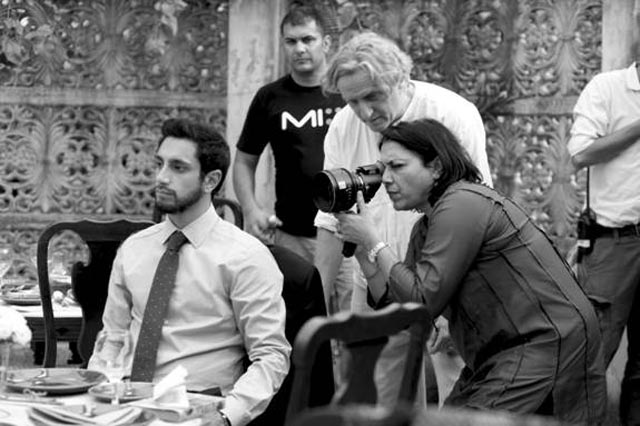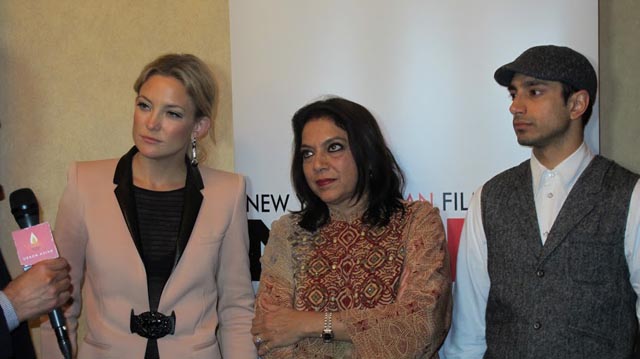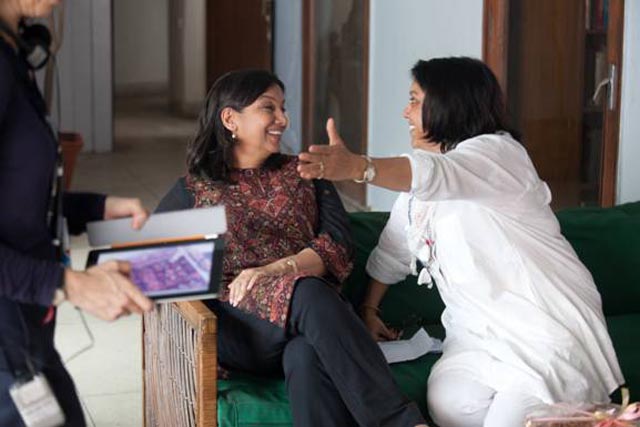
Mira Nair – Behind the Scenes
This year Mira Nair celebrates the 25th anniversary of her first feature film, the Oscar-nominated ‘Salaam Bombay’ and also the birth of her new film, ‘The Reluctant Fundamentalist’. On the eve of the release of ‘Salaam Bombay!’ in New York back in 1988, I had taken a subway downtown to interview the new, not-so-famous filmmaker in her tiny apartment. The world had not yet discovered ‘Salaam Bombay’ but she was exuberant, excited, animated.
Twenty-five years later, she seems exactly the same – exuberant, excited, animated. There have been critically acclaimed films from ‘Mississippi Masala’ to ‘Monsoon Wedding’ to ‘The Namesake’. The awards and accolades have been coming thick and fast.
‘The Reluctant Fundamentalist’ screened at The Venice International Film Festival and the Tribeca Film Festival, among others. Nair calls it her labor of love, five years in the making. Newsweek editor-in-chief Tina Brown threw a special screening and bash for her, and the New York Foundation for the Arts inducted her into its Hall of Fame. The film premiered in New York where Mira Nair was present, with actors Riz Ahmed and Kate Hudson, and author Moshin Hamid. It is releasing on 650 screens on May 17 in both India and Pakistan. The Urdu version will be called ‘Changez’. A film set in the changing American landscape after 9/11, it takes on difficult issues of religion and race.
Here are excerpts from an interview:
Q: What inspired you to make ‘The Reluctant Fundamentalist’?
I first visited Lahore in 2004 and was absolutely dazzled by the warmth and the largess of spirit of the city and of its great artistic expression. As a kid in modern India you don’t get to Pakistan that easily and my father who came from Lahore, was educated there and it was his city. We were raised in India and the partition separated us deeply but I was raised like a Lahori kid, speaking Urdu and knowing Faiz and great music – but I had never been there. When I finally went there, I thought it’s just such a different Pakistan from the one we read about in the newspapers. It’s an ancient culture like India is but it’s also desperately modern in artistic ways, in many ways.
Q: I heard your father had started an India-Pakistan Friendship Society but your family must have also felt the pain of the Partition. How did you arrive at the point you are at, where you could make this film?
My father was educated in Lahore but he came from the Punjab in India and he returned there before the Partition and joined the IAS. I grew up speaking a kind of Urdu – Hindustani – and knowing the music and the language so when I went to Pakistan years later when I was 47, it was like going home in a deepish way which I never expected.
Mohsin says I’m an Indian director making a Pakistani film – I appreciate that but for me there was never a border, I feel in my bones it is one. Living in multiple worlds as I do and yet feeling very rooted and being a fierce desi in my soul – I’ve always taken courage in being distinct, taken courage in knowing and remembering where we come from – but being totally open to the world. I wanted to bring that sensibility of the way I feel to the screen. With the polarities of our world, we need that.
Q: Your film gives a human dimension to Pakistan and populates it with real life characters. Can you talk about that?
Indian directors have always done the Partition but we’ve never done anything contemporary. For me especially, living in New York as I mostly do, what you read about is so different from what you see and know – and I feel a great lament that the conversation between the American world, the western world – and the Islamic world in broader strokes is not a conversation – it’s a monologue. You never hear the other side and this is what prompted the need for the other side to be heard. It was Mohsin’s brilliant novel that I read a year after I visited Lahore which gave me the bones of making this conversation because, like Mohsin, I have lived here and I have lived there, as much as half my life.

Q: Did you shoot in Lahore or did you have to create Pakistan in India?
We couldn’t shoot the whole Pakistan part in Lahore as I had wanted to because we didn’t get insurance to insure the huge actors who were in this movie and there was also the general insecurity. Also, the Lahore film industry is quite defunct and it’s mostly in Karachi so it’s a very expensive place. We went to Lahore for 3-4 days of second unit shooting so the street scenes are in Lahore but the interiors, riots scenes and teahouse were shot in Delhi. I’ve been to Lahore about five times so I had a barometer for it.
Old Delhi is the sister city to Lahore with the same history and architecture. I was very struck by the differences between India and Pakistan, just in terms of the clothing, the accents, the diet – so many little things. I love the differences! Mohsin and Meesha Shafi, who is a huge singer in Pakistan, carried from Lahore with them all kinds of details, like Bhutto posters, to make these streets look like Pakistan We brought a lot of talent from Pakistan – all our friends were with us and helping us.
Q: Riz Ahmed has received high praise as Changez Khan, the Reluctant Fundamentalist. How did you find him?
It’s a difficult role, and you need a worldliness, you need an elegance, an intelligence to play Changez. I found him in London after a year of searching in Pakistan and India. He had sent me a kind of dorky audition tape and I didn’t even take it seriously but then I asked him to do the scene with the father at the wedding – and he understood the cornerstone of sharam – shame – and izzat – honor, without my having to tell him. It was very moving. His is an absolutely charismatic performance and I’ m just so blessed.

Q. You have an international cast including two of India’s finest actors, Shabana Azmi and Om Puri. What were the special joys of working with these two actors?
A: I have known Shabana and Om for three decades, and through our friendship have longed to work with them. Just waiting for the right roles, really. Om is such a master, impossible to be anything but authentic – and the perfect Lahori Punjabi. And Shabana – besides sharing an uncanny resemblance to Mohsin Hamid’s mother – is such a giving actor and generous friend . It didn’t trouble her to play a supporting role – she inspired us all and was totally with the team at every turn. Having legendary actors such as them raises the bar on everything.
Q: The film has powerful music from qawallis to pop, from Fareed Ayas to Peter Gabriel – tell us about it.
Well, music is my breathing universe. Not only was I raised on the poems of Faiz but the modern sound coming out of Pakistan is just so inspiring – it’s old but it’s eternal in its modernity. Hearing the new sounds coming from there was amazing, including ‘Mori Araj Suno’ sung by Tina Sahni in the Coke Studio version. This movie went down three times – it was the hardest movie to finance. Every time it would go down, I would put on ‘Mori Araj Suno’ – which is ‘Hear me out, O Lord! If you don’t listen to me, I will change you for another God!” We re-did it in a male voice for Changez’s cry from the heart, with Atif Aslam, the great pop star of Pakistan. Music has been a great sustenance for me.
Q: There are so many disagreements between India and Pakistan, do you think your film is one on which they’ll both agree?
I think it’s definitely something that I’m so excited about, to be probably one of the first Indian directors to make a Pakistani film – and also bring it to America. I’m so happy to have been embraced in India – we won the Centenary Award for this film by the Indian Government and I was just so proud of my country that they could go into that space with the embrace of a piece of work that crosses our borders, that makes our borders really disappear. I’m hoping for the same in Pakistan.
(C) Lavina Melwani
(This article first appeared in The Hindu)

2 Comments
Via Facebook profile comments
Nita Anand, Sunaina Sen, Sharbari Zohra Ahmed and 6 others like this.
Tula Goenka “Not so reluctant filmmaker” : )
via Lassi with Lavina Facebook Page
15 people like this.
Sabina Himani – So enjoyed this Lavina … Mira Nair is such an inspiration.
Surekha Demarest – Thank you, Lavina for this wonderful piece. I have admired Meera Nair from the time she gave us “Salaam Bombay” – always amazed at how she captures tiniest nuances of characters.